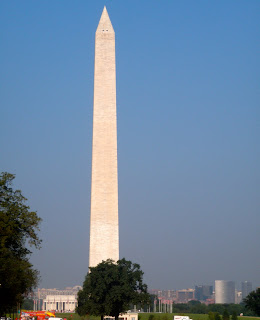 After a long day of travel by car and by train, we arrive in Washington D.C. for the final push of our adventure. The change of scenery (not to mention a considerably discounted room at the Ritz!), seems to rejuvenate us a bit as we take in the familiar sites and landmarks. After checking in to the hotel, we venture out into the big city, stopping at a riverside cafe overlooking the Potomac for some snacks. Here we pour over our various maps and travel brochures hoping to create some sort of itinerary for the next day. We spend the rest of the evening cruising the streets of Georgetown and getting our mountain town consciences acclimated to the hustle and bustle!
After a long day of travel by car and by train, we arrive in Washington D.C. for the final push of our adventure. The change of scenery (not to mention a considerably discounted room at the Ritz!), seems to rejuvenate us a bit as we take in the familiar sites and landmarks. After checking in to the hotel, we venture out into the big city, stopping at a riverside cafe overlooking the Potomac for some snacks. Here we pour over our various maps and travel brochures hoping to create some sort of itinerary for the next day. We spend the rest of the evening cruising the streets of Georgetown and getting our mountain town consciences acclimated to the hustle and bustle! We decide to attack our only full day in the capital with full force, and head out early for the nearest metro station. We don't go far, however, before realizing that we may have bit off more than we can chew! By the time we've walked the length of the National Mall and up the steps to the capital building, it's not even 9:00 in the morning, and we are soaked all the way through with sweat.
We enjoy a tour of the capital building, bobbing and weaving our way through the masses of humanity in order to sneak glimpses of the stunning paintings, statues, and intricacies of masonry. Our tour guide is a bit pushy, but knowledgeable nonetheless, and we are given interesting tidbits regarding the historical significance of the various rooms and artwork. At the conclusion of our tour, we quickly revise our game-plan, eliminating the "would like to sees..." and narrowing down the "musts."
Our next stop is the National Museum of the American Indian. A wonderful exhibit features the accomplishments of Native American musicians (such as Jimmi Hendrix... who knew?!) with sample recordings from each one. Another gallery focuses on the spirituality and mythology of various tribes throughout the Americas. When we discover that there is little devoted to the cultures related to our curriculum, we cut our tour short and head across the vast, sweltering lawn and steaming pavement towards The National Archives.
The Archives offered us the most relevant and intriguing information for our content. There is a very tangible realization inside this building that we, as Americans, have access to stacks and stacks of historical documentation that record the rights of citizens, the actions of Government officials, and the national experience. We are equally engrossed in a unique exhibit called "Discovering the Civil War." This features the most extensive display of unusual perspectives and many seldom seen documents dating back to before the Civil War. Spectators are urged to use the primary source documents to discover for themselves the answers to questions such as how did the South try to forge a National identity? What motivate men to enlist? What happened to those who resisted? As teachers of history, the access to and implementation of such documents is a skill we greatly desire to disseminate to our students.
By 2:00 the temperature is hovering somewhere around 100 degrees, and we've just about had enough! Reluctantly, we drag ourselves four more blocks to the Ford Theater--scene of Lincoln's assassination--where we have pre-purchased tickets to the museum and presentation. The restored historical site features artifacts and information about good old Abe's life and career, including the pistol responsible for cutting it short. A park ranger herds us all into the theater and gives a verbal play by play of Lincoln's final day. The presentation is somewhat anticlimactic, but it is surreal to be looking at the box where this famously tragic event in our nation's history unfolded.

Cranky, blistered, tired, and hot, we finally begin the long trudge back to Georgetown to debrief on all the new information we've just shoved into our already overflowing brains. It's been a long nine days, but we've accomplished an awful lot. More importantly, we can now bring back all our new learning to our students, and share first hand, the experiences we've had; it will bring life to our lessons, and the lessons we all share as citizens of this great nation. As Abraham Lincoln so aptly put it, "In the end, it's not the years in your life that count. It's the life in your years." Thanks for being a part of our journey!
Cindy Cassidy
Tracy Teetaert
Kristen Morgan
















































